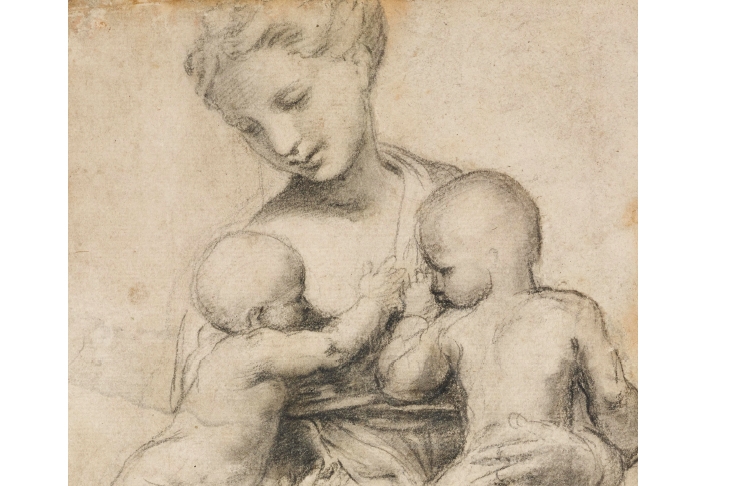Late one afternoon, early in the year, I was walking through the Vatican Stanze with a small group of critics and art historians. While we were admiring the Raphael frescoes that fill these private apartments of the Renaissance popes, Matthias Wivel, curator of the Michelangelo & Sebastiano exhibition at the National Gallery, made the most eloquent case for the painter I have ever heard. Suddenly, I felt a new enthusiasm for Raphael.
Essentially what he said is that Raphael is the supreme master of depicting human beings in interaction. Each of the frescoes around us, Wivel pointed out, was made up of a huge number of figures, all engaged with each other in fluently orchestrated groups. Indeed, Raphael organised his figures in almost musical terms — single notes, trios, quartets, cadences. The frescoes in that room are about the elements of civilisation. The ‘School of Athens’ is a choral assembly of philosophers — responding, debating, reacting, expounding. Other frescoes summarise the achievements of poetry, law and theology.
Here, Wivel argued, ‘You see people dependent on each other for the thoughts they express and the questions that they think about. This is what human civilisation is about; Raphael’s way of composing pictures is an expression of the fact that we can’t exist on our own. That’s why he is so intensely moving as an artist. He shows us the better angels of our nature: what we should aspire to as a society.’
In the modern age, many, I suspect, secretly feel Raphael (1483–1520) is a bit of a bore. Lucian Freud so detested his work he claimed he couldn’t tell which way up Raphael’s drawings were supposed to be. Even in the mid-18th century Joshua Reynolds confessed the ‘disappointment’ hehad felt on first seeing Raphaels in the Vatican Stanze.
Years later, in his Discourses on Art, Reynolds praised Raphael for all the academic virtues that an RA student ought to cultivate, such as ‘correctness’ of drawing. But when he came to weigh up which of the two Renaissance giants was the greater, Michelangelo or Raphael, it was clear where Reynolds’s heart lay. He described Michelangelo’s ‘vast and sublime’ ideas, ‘Poetic Inspiration’, ‘Genius and Imagination’. Raphael, in contrast, was awarded all the unthrilling qualities: ‘correct’ drawing, ‘judicious’ composition, ‘Taste and Fancy’.
This comparison — Michelangelo versus Raphael — is one that can be made for the next week by visiting the Michelangelo & Sebastiano exhibition (soon to close), then taking a train to Oxford to see the fabulous show Raphael: the Drawings at the Ashmolean Museum.
The 120 drawings demonstrate why for centuries Raphael was the most influential figure in western painting. Looking at them is like looking into his mind — you see ideas beginning, developing, being polished. In a few cases — such as an image of a horse’s head, charged with titanic energy — you see pieces of the cartoon: the full-scale template for the final picture.
Raphael was the great synthesiser of early 16th-century Italy. A generation younger than Leonardo (b.1452) and nearly a decade junior to Michelangelo (b.1475), he learnt from both and from his own master, Perugino. You can see the process of assimilation in the drawings he did after Leonardo’s ‘Leda and the Swan’ (c.1507) and Michelangelo’s ‘David’ (c.1504). Raphael’s version of Leonardo’s nude Leda comes out less weird, more sensual — much more the work of someone who liked looking at naked women (another of Raphael’s unique selling pointsin contrast to the two older artists). Similarly, his David — seen from behind — is more elegant than the original, and also less heroic.
Raphael wasn’t just mixing and matching other styles, there was an emotional tone that was all his own — graceful, urbane, but also full of subtle feeling. In a 16th-century dialogue on art, one of the speakers argues that Michelangelo represented porters — with mighty muscles that could only come from manual labour — whereas Raphael depicted gentlemen: a good joke, and a clue to the limitations of each.
It is clear that everyone liked Raphael, the man. He was charming and easy to deal with. This was perhaps because he possessed a high level of empathy, which might have been why — unlike Michelangelo, who was notoriously cantankerous and antisocial — Raphael was a supreme portraitist.
His emotional intelligence is visible in a great drawing such as ‘Heads and Hands of Two Apostles’ (c.1519–20), which ends the exhibition. You can read their reactions of awe at and reverence to the miracle in their faces — and also in the language of their gesturing fingers (a speciality of Raphael’s).
Such highly detailed drawings, worked up with observations of living models, were a late phase in his working process. Raphael usually began with the idea for the whole composition. Then, when he had planned the rhythms and melodies, he would look at the individual components, studying them, often posed naked in his studio, to get the anatomy just right.
Yet such studies aren’t exercises in truth-telling (which is no doubt why Lucian Freud hated them). His ‘Study for Psyche presenting to Venus the Vase of Proserpine’ (c.1517–18) is as delicately erotic as a Watteau — and clearly based on observations of a real body. But as he drew, he was altering, idealising — transforming her into a goddess.
Fortunately, we don’t have to choose (if I were forced, I would still plump for Michelangelo). But this exhibition makes Raphael’s genius clear. True, some of his magical charm has faded with time; I doubt anyone will ever again warm to those vapid Madonnas of his. But there is so much tender, brilliant and beautiful draughtsmanship on show that you could stay there all day, just looking.






Comments